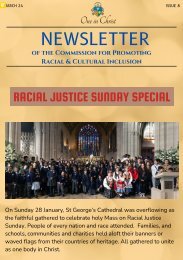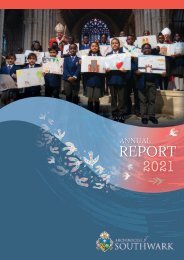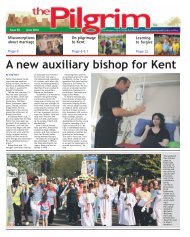Issue 03 - The Pilgrim - March 2012 - The newspaper of the Archdiocese of Southwark
The March 2012 issue of "The Pilgrim", the newspaper of the Archdiocese of Southwark
The March 2012 issue of "The Pilgrim", the newspaper of the Archdiocese of Southwark
- No tags were found...
Create successful ePaper yourself
Turn your PDF publications into a flip-book with our unique Google optimized e-Paper software.
Features <strong>The</strong> <strong>Pilgrim</strong> <strong>March</strong> <strong>2012</strong><br />
Bookcase<br />
My Favourite book<br />
Bishop Paul Hendricks<br />
detects a Christian dimension in<br />
J.K.Rowling’s best-selling Harry<br />
Potter series.<br />
Cutting <strong>the</strong> fabric <strong>of</strong> her<br />
faith to suit <strong>the</strong> Stations<br />
I don’t know if I have a single favourite<br />
book, but <strong>the</strong> Harry Potter series<br />
would certainly be high up on my list.<br />
<strong>The</strong>re is a strong plot line, a range <strong>of</strong><br />
well-developed characters, humour —<br />
and some moral and emotional depths,<br />
which come through more strongly as<br />
<strong>the</strong> series<br />
continues.<br />
Harry is a good person, but he is not<br />
over-idealised. He is by nature a rebel,<br />
not above breaking school rules. He<br />
makes mistakes: for example in <strong>the</strong><br />
last book, he has a row with his friend<br />
Ron that he could probably have<br />
avoided, and which causes much pain.<br />
He has a very strong sense <strong>of</strong> what is<br />
right, and <strong>of</strong>ten sacrifices his own selfinterest<br />
because <strong>of</strong> this, but he still<br />
has to struggle with anger in various<br />
situations.<br />
Drama <strong>of</strong>ten arises from <strong>the</strong> shortcomings<br />
<strong>of</strong> <strong>the</strong> adults.<br />
Pr<strong>of</strong>essor Snape hates Harry, whose fa<strong>the</strong>r<br />
was his boyhood enemy.<br />
Different aspects <strong>of</strong> this history<br />
emerge through <strong>the</strong> series, with Harry<br />
at times forced to reconsider what he<br />
thought he knew about his fa<strong>the</strong>r. We<br />
only get <strong>the</strong> full picture at <strong>the</strong> end,<br />
when Snape himself has been killed.<br />
<strong>The</strong>n we realise why he behaved as<br />
he did and we’re left with <strong>the</strong> sadness<br />
<strong>of</strong> knowing what might have been, if<br />
only things had worked out a little bit<br />
differently.<br />
Though <strong>the</strong> books do not refer directly<br />
to religion, <strong>the</strong>re is an<br />
intriguing parallel with Christianity in<br />
<strong>the</strong> final book. Harry can only defeat<br />
evil by allowing himself to be killed by<br />
his enemy.<br />
<strong>The</strong>re is a scene towards <strong>the</strong> end,<br />
where he faces up to <strong>the</strong> fact that he<br />
must deliberately walk to his death — a<br />
sort <strong>of</strong> Gethsemane scene, in fact.<br />
As I read, I knew Harry must come<br />
through somehow, but I admit I<br />
couldn’t see how. With typical skill,<br />
<strong>the</strong> author did solve <strong>the</strong> problem – and<br />
in terms which fitted in perfectly with<br />
what had already been revealed earlier<br />
in <strong>the</strong> story.<br />
This was an ending that, like <strong>the</strong> series<br />
as a whole, was not only cleverly<br />
done but genuinely moving as well.<br />
Canadian textile artist Anne Kelly tells Greg<br />
Watts how she went about illustrating Steps <strong>of</strong><br />
Pain, Steps <strong>of</strong> Hope; Reflections on <strong>the</strong> Way <strong>of</strong><br />
<strong>the</strong> Cross by Monsignor Mat<strong>the</strong>w Dicken, vicar<br />
general <strong>of</strong> <strong>Southwark</strong> diocese.<br />
“I had collaborated previously with Monsignor<br />
Dicken on <strong>the</strong> design and production <strong>of</strong> an embroidered<br />
hanging for Pope Benedict XVI’s visit to London<br />
in 2010,” she says.<br />
“I started <strong>the</strong> research for <strong>the</strong> stations by looking<br />
at traditional and modern interpretations. I<br />
looked at Gill’s work in Westminster Ca<strong>the</strong>dral,<br />
but also less well-known examples, such as a Scottish<br />
printmaker called Adrian Wiszniewski.<br />
“I wanted <strong>the</strong> stations to have a unifying motif<br />
so used <strong>the</strong> geometric layout reminiscent <strong>of</strong><br />
stained glass windows as a background. <strong>The</strong>y were<br />
to be reproduced (all but <strong>the</strong> cover) in black and<br />
white, so I decided to use shades <strong>of</strong> white, grey<br />
and black.<br />
“<strong>The</strong> first station was hard to produce, as it<br />
would set <strong>the</strong> tone for <strong>the</strong> images following it.<br />
Once I had started <strong>the</strong> series, <strong>the</strong>y developed organically<br />
and it was easier to decide on <strong>the</strong>ir layout<br />
and format.”<br />
She says that two <strong>of</strong> <strong>the</strong> stations particularly<br />
pleased her. ‘<strong>The</strong> first, as I love <strong>the</strong> pattern <strong>of</strong> <strong>the</strong><br />
water falling, and <strong>the</strong> sixth, where Veronica wipes<br />
<strong>the</strong> face <strong>of</strong> Jesus. This was chosen as <strong>the</strong> cover<br />
design and was produced as an embroidered<br />
piece.’<br />
Anne was born in Montreal and trained as a fine<br />
artist and say that because <strong>of</strong> this much <strong>of</strong> her<br />
work starts with drawing. “I draw in stitch and<br />
keep sketchbooks, <strong>of</strong>ten painting as well. I started<br />
to produce and exhibit multi-layered textiles<br />
based on natural forms in 2004.<br />
“<strong>The</strong>y were very well received and developed<br />
into larger narrative pieces and commissions. I use<br />
a mixture <strong>of</strong> techniques, including machine and<br />
hand stitching, collage and appliqué. I am currently<br />
co-writing a book on collaborative textiles,<br />
Connected Cloth, due out next year.”<br />
She lives in Tunbridge Wells, where she has a<br />
studio. She teaches art and textiles part-time at a<br />
small independent school near Goudhurst.<br />
“My studio is a repository for all kinds <strong>of</strong> fabric,<br />
art and textile materials and working <strong>the</strong>re is inspiring<br />
and motivating. I collect old and forgotten<br />
domestic textiles and clothing, which I like to<br />
reuse and incorporate as whole pieces or in sections<br />
<strong>of</strong> my work.<br />
“I am <strong>of</strong>ten given pieces <strong>of</strong> fabric and whenever<br />
I travel anywhere, whe<strong>the</strong>r at home or abroad. I<br />
love collecting fabric and haberdashery.”<br />
www.annekellytextiles.com<br />
Dickens 200th celebration<br />
This year is <strong>the</strong> 200th anniversary<br />
<strong>of</strong> <strong>the</strong> birth <strong>of</strong><br />
Charles Dickens and <strong>the</strong>re<br />
are many events in London<br />
and Kent to celebrate <strong>the</strong><br />
man who is arguably Britain’s<br />
greatest ever novelist.<br />
Until June 10 <strong>The</strong> Museum<br />
<strong>of</strong> London is running an exhibition<br />
entitled Dickens in<br />
London. It includes original<br />
and rarely seen manuscripts<br />
<strong>of</strong> his most famous novels,<br />
including Bleak House and<br />
David Copperfield.<br />
Excavated items from<br />
Jacob’s Island in Bermondsey,<br />
depicted by Dickens in<br />
Oliver Twist, will also be on<br />
show. <strong>The</strong> National Portrait<br />
Gallery has a display <strong>of</strong><br />
prints, drawings and photographs<br />
<strong>of</strong> Dickens’ life. It<br />
runs until 22 April.<br />
Author Lucinda Dickens<br />
Hawksley will be giving a<br />
talk called Why Dickens still<br />
matters at 11 am on 7 <strong>March</strong><br />
at Gravesend Visitor Centre.<br />
She will examine <strong>the</strong> man<br />
behind <strong>the</strong> books, his journalism,<br />
social campaigning<br />
and how he made a difference<br />
to <strong>the</strong> world in which<br />
he lived and why his ideals<br />
remain relevant today.<br />
Elsewhere, <strong>The</strong> Brook <strong>The</strong>atre<br />
in Chatham will be<br />
showing Adrian Preater’s<br />
adaptation <strong>of</strong> Great Expectations<br />
at 7.30pm on 17 <strong>March</strong>.<br />
In May <strong>the</strong> Cuming Museum<br />
in Walworth Road will stage<br />
an exhibition about <strong>the</strong><br />
poverty and social injustice<br />
in <strong>Southwark</strong> during <strong>the</strong> time<br />
<strong>of</strong> Dickens’ childhood.<br />
Artist Maggi Hambling has<br />
been commissioned to design<br />
a sculpture to illustrate<br />
Dickens’ relationship with<br />
<strong>the</strong> Borough area. It will be<br />
erected in <strong>the</strong> Tabard Street<br />
piazza between St George<br />
<strong>the</strong> Martyr, which featured in<br />
Little Dorrit, and <strong>the</strong> site <strong>of</strong><br />
<strong>the</strong> Marshalsea Prison.<br />
Movie tells<br />
story <strong>of</strong> Opus<br />
Dei founder<br />
<strong>The</strong>re Be Dragons, a movie portraying <strong>the</strong><br />
life <strong>of</strong> Opus Dei founder Josemaria Escriva,<br />
is now available on DVD.<br />
<strong>The</strong> film tells <strong>the</strong> story <strong>of</strong> two childhood<br />
friends, Josemaría and a fictional character<br />
Manolo and how <strong>the</strong>ir lives take very<br />
different paths in <strong>the</strong> midst <strong>of</strong> <strong>the</strong> Spanish<br />
Civil War<br />
It was directed by Roland J<strong>of</strong>fe, whose<br />
credits include <strong>The</strong> Mission and <strong>The</strong> Killing<br />
Fields, and shot in Spain and Argentina<br />
A release date for cinemas in <strong>the</strong> UK has<br />
yet to be set.<br />
Page 10


















